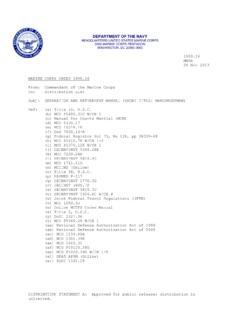Transcription of Quality Management Program Goals and Objectives - PA
1 Quality Management (QM) Program Goals and Objectives The Goals and Objectives of the QM Program are: To improve the Quality of medical and behavioral health care and service provided to Members through administrative simplification and a comprehensive and ongoing system of monitoring measurable performance indicators (including indicators based on high-volume, high-risk, and problem-prone services, data from customer satisfaction surveys, complaints/occurrences, and appeals, and other relevant sources), evaluating results relative to established Goals and benchmarks, and acting to promote improvement To maintain a process for adopting and updating both preventive health guidelines and non-preventive ( acute and chronic) clinical practice guidelines for both medical and behavioral health related conditions which are evidence-based, ensuring dissemination to Plan practitioners and Members to facilitate decision-making about appropriate health care for specific clinical circumstances To identify, develop, and/or enhance activities that promote Member safety and encourage a reduction in medical errors.
2 This includes medication errors through a Program of Member and practitioner/provider focused educational initiatives and profiling activities, that may include, but are not limited to, data from claims, medical record reviews, surveys, complaints/ occurrences, and pharmacy claims To ensure a network of qualified practitioners and providers by: demonstrating compliance with all applicable accrediting and regulatory credentialing/ recredentialing requirements. including language in practitioner/provider contracts requiring participation in the QM Program and access to medical records. To promote communication with practitioners/providers of care/service about Quality activities, providing feedback on results of plan-wide and practice-specific performance assessments, and collaboratively developing improvement plans To disseminate information on practitioner/provider performance to promote Member empowerment and informed decision making To ensure that the Quality of care and service delivered by delegates meet standards established by us and relevant regulatory agencies, and that delegates maintain continuous, appropriate, and effective Quality improvement programs through ongoing oversight activities and regular performance assessments To document and report the results of monitoring activities, barrier analyses, recommendations for improvement activities.
3 And other Program activities to the appropriate committees To comply with all regulatory requirements, to achieve and maintain accreditation, and necessary certification To ensure that the appropriate resources are available to support the QM Program QM Program Activities/Initiatives QM Program Activities Four Broad Categories: 1) QM Program Administration Staff in the QM department support the QM Program , through a number of activities including: Monitoring compliance with standards established by regulatory and accrediting bodies such as National Committee for Quality Assurance (NCQA) and the Centers for Medicare & Medicaid Services (CMS) Maintaining Quality Program policies and procedures, evaluating the programs effectiveness and supporting AmeriHealth s Quality Committees Overseeing services provided by vendors to which we have delegated the provision of certain services, such as behavioral health care 2) Clinical Quality Activities AmeriHealth has initiated a series of Member- and physician-focused outreach activities designed to promote improvements in a number of areas including, but not limited to.
4 Preventive Care and Wellness Promoting prevention and wellness activities based on the demographics of the Members served ( , age, sex, and health status) including, but not limited to, immunizations for children, adolescents and adults; women s health reminders for breast cancer screening; cervical cancer and chlamydia screening; osteoporosis care; and colorectal screening as well as fitness, wellness, and safety programs Acute and Chronic Conditions Monitoring aspects of care for Members with acute and chronic conditions including, but not limited to: Members with asthma, coronary artery disease, chronic obstructive pulmonary disease, chronic heart failure, diabetes, end-stage renal disease, and other acute and chronic conditions; prenatal care for expectant mothers; and decision support services Clinical Practice Guidelines Maintaining a process for adopting and updating both preventive health guidelines and non-preventive ( , acute and chronic) clinical practice guidelines for both medical and behavioral health related conditions to help practitioners and Members make decisions about appropriate health care for specific clinical circumstances.
5 The Plan adopts evidence-based guidelines from nationally recognized sources or involves board-certified practitioners from appropriate specialties in the development or adaptation of its evidence based clinical practice guidelines. Adapted clinical practice guidelines are reviewed and approved by the Plan s Quality committees. 3) Network Quality Activities A number of activities are undertaken to foster improved communications between the Plan and the network of Participating Practitioners and Providers and to promote improvements in the Quality of services delivered by the network. These activities include, but are not limited to: Investigating and tracking potential Quality of care concerns through complaint and occurrence reporting Medical record standards Monitoring access, availability, and cultural competence Monitoring continuity and coordination of care Monitoring appropriate utilization of services Promoting Member safety 4) Service Quality Activities The Plan has established performance indicators and Goals to monitor Member satisfaction and the services provided to the Plan s Members.
6 When Plan performance falls below goal, initiatives are implemented to improve Member and provider satisfaction. A broad range of performance indicators have been established which pertain to a number of areas including, but not limited to: Claims Processing enrollment Member Services Provider Services Care Management and Coordination (CMC) Member Safety Activities The QM department utilizes Plan-wide activities that promote and support providers and Members in implementing safe practices and reducing medical/medication errors. These activities include: communicating information about Member safety and prevention of medical/medication errors through Member and provider mailings and newsletters; communicating outcomes from Quality monitoring activities; supporting regulatory standards; and implementing initiatives that promote Member safety and the reduction of medical/medication errors.
7 Quality Improvement For more information about our QM Program , including information about Program Goals and a report on our progress in meeting those Goals , please visit our website at You may also contact Member Services at the telephone number on your ID card. AmeriHealth PA HEDIS Effectiveness of Care Measures 2005 (Reporting Year 2004) 2006 (Reporting Year 2005) 2007 (Reporting Year 2006) Antidepressant Medication Management Optimal NA NA NA Effective Acute NA NA NA Continuation Phase NA NA NA Adolescent Immunization Combo 2 (MMR, Hep B, VZV)received the 2nd MMR, 3 Hepatitis B vaccinations; and on VZV prior to 13th birthday Appropriate Testing for Children with Pharyngitis NA NA NA Appropriate Treatment for Children with URI Beta Blocker Treatment after a Heart Attack NA NA NA Breast Cancer Screening Cervical Cancer Screening Childhood Immunization (New) Combo 2 (received 4 DTaP/DT, 3 IPV,1 MMR, 3 HiB, 3 Hepatitis B, and VZV vaccination before 2nd birthday) Chlamydia Screening in Women Ages 16-20 Ages 21-25 Combined Cholesterol screening after AMI (LDL-C)
8 Cholesterol controlled after AMI <100 Colorectal Cancer Screening Comprehensive Diabetes Care Eye Exam HbA1c Testing Poor HbA1c Control LDL-C Screening LDL-C Controlled < 100 Monitoring for Diabetic Nephropathy Controlling High Blood Pressure** Follow-Up After Hospitalization for Mental Illness Within 7 days of discharge NR Within 30 days of discharge NR Prenatal Care in the first Trimester Post Partum Care Use of Appropriate Medications for People with Asthma** Ages 5-9 NA NA NA Ages 10-17 NA NA NA Ages 18-56 NA NA NA Combined NA NA **2007 HEDIS - Changes made to specifications for the measure **2006 HEDIS - Changes made to specifications for the measure NA Eligible population too small to report rates AmeriHealth PA HMO/POS 2007 Member Satisfaction Survey Results Rating of Health Plan Rating of Overall Experience with the Health Plan (Rated 8, 9, or 10 on a 10 point scale) Rating of All Health Care Rating of All Healthcare (Rated 8, 9, or 10 on a 10 point scale)
9 Rating of Personal Doctor Rating of Pesonal Doctor or Nurse (Rated 8, 9, or 10 on a 10 point scale) Rating of Specialist Rating of Specialist Seen Most Often (Rated 8, 9, or 10 on a 10 point scale) Claims Processing Evaluates Correct and Timely Handling of Claims The composite score is the overall percentage of members who responded Always or "Usually" to when asked, how often did your health plan handled their claims quickly and how often their health plan handle your claims correctly Getting Needed Care Evaluates the Ease with which Members Can Access Care They Need The composite score is the overall percentage of members who responded Always or "Usually" when asked how often it easy to get appointments with specialists and oftenit easy to get the care, tests, or treatment they thought they needed through their health plan.
10 Getting Care Quickly Evaluates the Ability of Members to Access Care Quickly The composite score is the overall percentage of members who responded Always or Usually when asked, how often they got care as soon as they thought they needed it when care was needed right away and how often they got an appointment for routine care at a doctor's office or clinic as soon as you thought you needed? How Well Doctors Communicate Evaluates the Communication Between Doctor and Patient The composite score is the overall percentage of members who responded Always or Usually when asked how often their personal doctor explained things in a way that was easy to understand, listened carefully to them, showed respect for what they had to say and spent enough time with them.







